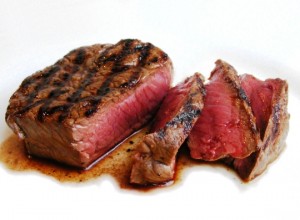 Have you ever cut into a dry, overcooked, gray piece of steak and wondered why you bother? Maybe you’ve bought into the old wives tale that rare meat is bad for you, so you think the only way you can enjoy a steak is to eat one with all the joy cooked right out of it.
Have you ever cut into a dry, overcooked, gray piece of steak and wondered why you bother? Maybe you’ve bought into the old wives tale that rare meat is bad for you, so you think the only way you can enjoy a steak is to eat one with all the joy cooked right out of it.
Well, that’s just not true. In fact a medium rare steak is far better for you than one that’s cooked past medium. Don’t believe it? Well, allow me to prove it to you.
When you cook a piece of meat in the presence of sugar or fat, you alter its protein structure. The more you cook it, the more the proteins change. The process is called glycation. Glycation makes the outside of a piece of meat turn brown when you cook it. A similar process called lipoxidation occurs when you cook meat in fat. The more you overcook meat, the more proteins are damaged.
And then several bad things happen.
A diet high in glycated or lipoxidized proteins contributes to heart disease, diabetes, and renal failure. Glycation and lipoxidation also make it much more difficult for your body to digest and use proteins for good things like building muscles.
Eating foods that are overcooked increases the level of glycotoxins in your body. Glycotoxins are the end result of glycation in your body. See, when you eat foods damaged by glycation, you increase your own levels of glycation. The resulting glycotoxins begin to build up in your collagen, in your arteries, in your brain, and in other vital organs where they age your body at a faster than normal rate.
Research shows that consuming foods with high levels of glycation, increases the circulation of glycotoxins which directly increase inflammation levels in your body and increase your body’s level of oxidative stress.
Keep Yourself From Getting Cooked on the Inside
Essentially when you eat a lot of glycated foods, you end up cooking your body from the inside out. You toughen and brown your own proteins. Not good.
To stop this process from running wild in your body, start by cooking your foods with more care. Steaming and poaching are great ways to prevent glycation and lipoxidation in your cooking. And serve up medium rare steaks instead of well done ones.
You can do even more to protect your body by increasing your levels of carnosine. Carnosine is a dipeptide that the neurons in your brain and the cells that make up your muscles use to protect themselves from glycation and glycotoxins. You can increase your body’s levels of carnosine by supplementing with 1000 mg of carnosine or by supplementing with up to 3 grams of beta-alanine. Beta-alanine is a pre-cursor to carnosine and is proven to increase carnosine levels.
By taking care with how you cook your food and taking steps to increase your body’s carnosine levels, you can enjoy your food more and slow down the aging and disease process in your body. That’s not a bad deal.
Stay well,
Mark Rosenberg, M.D.
